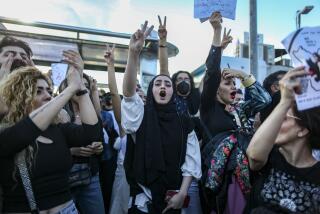Iran’s nomads going extinct
DASHT-E-BOZORG, IRAN — As a chill wind blows in, the Bakhtiari nomads pack up at the end of summer and start a long journey -- women and kids on horseback, men on foot, belongings in tow -- for the warmer regions here in southwestern Iran.
In April, when the desert heat begins to fire up, they will make the reverse trip to the cool, mountainous regions more than 100 miles to the north, crossing flood-swollen rivers and mountain passes to better grazing lands for their goats and sheep.
“This has been our way of life as long as history can remember. We’ve got used to this lifestyle,” Hasan Qoli Soleimani said in his home -- a large black tent made of tough goat hides.
Every winter, Soleimani and his family settle in Dasht-e-Bozorg, a region outside Shoushtar, a city in oil-rich Khuzestan province.
Iran has one of the largest nomadic populations in the world, an estimated 1.5 million in a country of about 70 million, according to the government’s agency for nomad affairs.
But experts say it’s a way of life that is slowly disappearing.
“Nomadic life is on the brink of extinction. If this trend continues, there will be no more nomads living in Iran in the next 20 years,” researcher Ali Qoli Mahmoudi Bakhtiari said.
“Few grazing lands and water resources are left for them. Nomadic life will soon be legend,” said Bakhtiari, a retired professor of linguistics and Persian literature.
Numbers for the decline are hard to come by. The government’s figures show the population down 200,000 from a century ago, but Bakhtiari said that didn’t show the real rate of the fall, which he said had accelerated in recent years. The attractions of urban life draw some away from nomadism, and the construction of factories, roads and the growth of cities eat away at the pastures where nomads’ goats and sheep once grazed.
The changes in lifestyle are clear in the village of Abid, where settled members of the Bakhtiari ethnic group -- to which Soleimani belongs -- live in mud-brick homes on the edge of the desert.
The Bakhtiaris, who speak a Persian dialect known as Luri, are one of two main nomadic groups in Iran, along with the ethnic Turkic Qashqai group.
Soleimani’s encampment, about 25 miles from Abid, was a collection of six tents, occupied by his relatives and their families, in a hilly region where herds of goats and sheep grazed.
Soleimani’s wife, Golbanou, wove their tent last year before the trip north. As Soleimani spoke, Golbanou -- mother of three children -- baked bread in a small mud brick oven. Next to her, a kettle filled with fresh meat, potatoes, beans, peas and tomatoes bubbled over an open fire.
Their elder son was outside, playing a small homemade flute as he took care of the livestock. Their daughter, Belqeis, wove a sheep’s wool jacket for her older brother as her younger brother, a 4-year-old, played outside.
Belqeis wore a colorful long shirt with a pink head scarf, a distinctive style of the Bakhtiaris.
“This is a symbol of our cultural identity,” she said, pointing to her shirt. The father had a round black hat and a long cream and black coat, hand woven by his wife.
But Soleimani sees the path of his ancestors eroding, with some of his own relatives giving up nomadic life and settling in cities.
“Some of those who went to study never returned,” he said. “Perhaps they had enough money to make ends meet in big cities. We don’t have such an opportunity.”
Oil and gas exploration activities in the region near Shoushtar and Masjid Soleiman have taken their toll on grazing lands.
The government pays little attention to nomadic groups, though it has started a program of “tent schools” to ensure children are literate. Although it does not directly encourage nomads to settle down, many of its industrial projects use up their pasture lands.
Soleimani says he never wants to abandon his life of motion.
“I don’t like to live in a house where there is a ceiling. It’s suffocating to me.”
More to Read
Sign up for Essential California
The most important California stories and recommendations in your inbox every morning.
You may occasionally receive promotional content from the Los Angeles Times.










